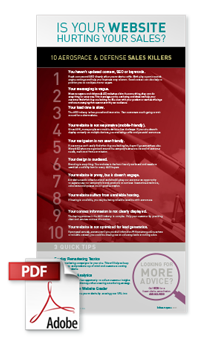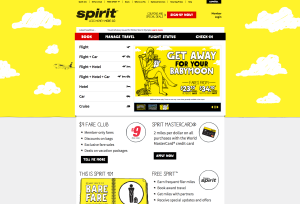Category: Digital Marketing
10 Ways Your A&D Website is Silently Killing Sales
Information from Forrester Research Inc. shows that B2B marketers still spend the lion’s share of their budgets on in-person trade shows and events, closely followed by digital advertising/marketing, with content marketing, websites, and digital marketing tied for third place, followed by a broad range of other expenditures.
 Our experience in aviation, aerospace and defense marketing confirms the Forrester findings. Events and conferences that facilitate in-person connections still reign supreme in our industry. However, we also see that website updates and development have become a priority for many clients.
Our experience in aviation, aerospace and defense marketing confirms the Forrester findings. Events and conferences that facilitate in-person connections still reign supreme in our industry. However, we also see that website updates and development have become a priority for many clients.
In some cases, these marketers have realized that the time has come to modernize their current site for content, design and functionality. But, increasingly, the need to update a website is driven by a higher-level strategy to use the site as the hub of a larger marketing effort, often an inbound marketing program designed to generate leads from a pool of self-directed buyers who navigate the sales process without the help of a sales rep. In fact, Forrester reports that today’s B2B buyers are two-thirds to 90 percent of the way through their purchase journey before reaching out to the vendor they have found online.
The reality is that your website can work for you or work against you. It can enable sales — or it can kill them. Want to see how your website stacks up? Check out this list of 10 A&D Sales Killers.
[vc_separator type=”” size=”” icon=”plane”]
If you like this blog you may also be interested in:
The 9 Things You Must Consider Before Redesigning Your Website
Audio: Lead Generation Case Study
This Marketing Flight Manual is downloadable audio content.
Is lead generation important to your business? This week, we sit down with Business Development Executive Ashley Cutler and VP of Client Services Lisa Sifuentes as they discuss their efforts on a recent lead generation campaign with host and Senior Designer Nick Markwardt. As you will hear, the results were nothing short of astounding.
Play this week’s session below or click here to download the MP3.

The full case study, including additional metrics and tips for improving your own lead generation efforts, will be available for download here on the Marketing Flight Manual next week.
[vc_separator type=”” size=”” icon=”plane”]
Lead Generation resources you might also be interested in:
Audio: Budget-Friendly Marketing
This week, BDN Aerospace Marketing is venturing into the world of downloadable audio content.
In this, our first audio installment, BDN founding partner Kyle Davis and VP of Client Services Lisa Sifuentes share some of their favorite ideas for getting the most out of a tight marketing budget. Senior Designer Nick Markwardt guides the discussion as we touch on topics ranging from developing an annual plan and leveraging digital tools, to identifying and challenging budget-sapping “sacred cows.” In just 15 content-filled minutes, we reveal that good marketing doesn’t have to be expensive marketing.
Play this week’s session below or click here to download the MP3.

Resources mentioned in the show:
7 Discouraging, Surprising, Yet Hopeful Truths About Modern Aerospace Marketing

BDN routinely uses research to understand, benchmark and report the trends and realities impacting the work we do as aerospace marketers.
In our most recent survey we asked aerospace marketers questions about their approach to budgeting and planning, goal-setting, goal accomplishment, their most effective tools and techniques, and levels of satisfaction with their company’s marketing performance.
We wondered, “Is there a correlation between those who plan and those who get results?” “Are some tactics consistently much more effective than others?” And, “Do budgets equate to higher perceived performance?”
It turns out that the answer is yes to all these questions, yet there is still much to be learned. Today we are providing a high-level summary of our findings with key takeaways and insights that shine a light (not always a flattering one) on our industry and our profession. This is ideal for those who want a quick read.
Anyone who would like more in-depth charts and findings may request the complete survey results here.
And remember, these results are suggestive, not scientific.
Key Insights & Takeaways
Finding: Regardless of their annual revenue, aerospace companies are still under-spending on marketing, with many high-revenue businesses spending just as little as their lower-revenue counterparts.
Insight: Shame on us. It’s hard to believe, but 20% of the $100,000,000 businesses have marketing budgets under $100,000. That’s an embarrassingly small .001%, and far below recommended spending and benchmarks for both B2B and our industry.
Takeaway: The budgeting process in larger companies sometimes defies logic, with decision-makers removed from the realities of individual functions. Verbatim comments tell us that more than a few companies are actually cutting marketing because industry conditions are bad. Huh? Marketers who work for an organization like this can either use data and measurement to become agents of change from within, remain ineffective, or run.
Finding: Most marketing budgets have stayed the same since 2015; a good number have increased; and very few have been cut.
Insight: Yes, this is positive news, but remember, budgets are still below accepted standards. Harvard Business Review generally suggests investing 3% of revenue in marketing, with adjustments made for specific scenarios.
Takeaway: Management probably believes marketing has everything it needs to be successful. After all, they have added or maintained existing budgets. But we can and must do better. If you are working with a limited budget, stop defaulting to old school tactics that can’t be measured — and when management wants you to do the same old, same old, explain that you can’t afford anything that fails to deliver ROI. Position yourself as the expert and start showing results to upper management that will justify the higher budget you know you need.
Finding: The majority of respondents say they do have and follow a marketing strategy and plan, yet there are striking differences here based on company revenue. More than 90% of the largest companies have a plan; less than 50% of the smallest do.
Insight: The survey shows that those with a strategy and plan are more satisfied with their company’s marketing performance than those without. It also shows that, as spending levels rise, so do levels of satisfaction with overall marketing performance.
Takeaway: A strategy, plan, adequate budget and measurement are the keys to your marketing success, regardless of company size. But if you are working with a smaller budget, strategy and planning become even more critical to ensure that every dollar spent is associated with an expected, measurable outcome.
Finding: Most respondents reported success in accomplishing key objectives. Improved brand awareness, improved customer engagement/relationships and increased sales were most frequently cited. Interestingly, 12% of those spending less than $100,000 report that they accomplished none of their objectives last year – no one spending $1 million or more said they accomplished nothing.
Insight: Regardless of budget, brand awareness and leads were cited as top successes. Because brand awareness is more difficult to measure it may be a more comfortable “metric” for some marketers. Challenge yourself to achieve more measurable objectives moving forward.
Takeaway: People are reporting success, and that’s good. Let’s just make sure those claims of success are based on data you can defend.
Finding: The most effective digital marketing efforts were websites (83%) and email marketing (79%). The highest marks for ineffective tactics were social media, blogs and online display ads, yet plenty of marketers also found them effective.
Insight: One, people are divided about what works in the digital realm. Also, while websites are recognized as effective, less than 50% say their SEO is effective.
Takeaway: We think the sheer volume of new and changing tools and options overwhelms many marketers. The first step to using the right digital tactics is understanding them – make time to get smart and use data to determine what is and is not working.
Finding: The most effective traditional marketing efforts were events and print advertising, yet print advertising also was most frequently called out as ineffective.
Insight: We continue to rely on old school tactics, perhaps to appease older, old school management, that are less likely to be measured.
Takeaway: If you are using events and print advertising (often the most expensive tactics) make sure you are tracking results. There are tools and techniques that make it possible to know if these approaches are working.
Finding: In 2016, marketers overwhelmingly say their No. 1 objective is increasing sales, followed by improved customer engagement, increased leads and improved brand awareness. Also, their No. 1 challenge is acquiring new customers, followed by lead generation and measuring ROI.
Insight: Hurray! Marketing exists to drive sales, and we are heartened to see folks acknowledging this connection.
Takeaway: Take a look at the relationship between marketing and sales in your organization. Are you using a CRM and marketing automation system to facilitate tracking, measurement and accountability? Are you working harmoniously toward a common goal? Or is there friction and finger pointing? Make mending and strengthening these relationships — adding in accountability for everyone — a priority for the good of the business.
Next up:
Keep reading next week for verbatim comments from more than 30 respondents who wrote to us about the challenges, opportunities and trends they are experiencing in their aerospace marketing work.
Don’t forget:
If you liked this blog post, you may also be interested in these free BDN resources:
- How to Develop a Marketing Communications Budget
- Budget Planning Checklist
- Marketing Planner
- 30 Days to Better Digital Marketing
Website Basics Checklist
We’re capping off February’s month-long focus on websites with a checklist to guide you through the web development process.
Following these guidelines will ensure that your new website is built on a solid foundation. Or, use it to assess your current site and identify areas in need of improvement.
In addition to viewing the checklist below, you can download and save it for future reference.
SEO Basics for A&D Marketing
 Bad SEO. It happens more than you might think.
Bad SEO. It happens more than you might think.
You just refreshed your aerospace company website, and it looks and sounds great. But no one is seeing it because you forgot about optimizing your website for search engines.
Sure, lots of customers are finding you through referrals and at trade shows, but more and more are looking for you online. In fact, 94 percent of business buyers do at least some type of online research, so search engine optimization (SEO) matters.
No need to feel overwhelmed or intimidated. Search engines, like Google, Yahoo, or Bing, use multiple factors to determine exactly where your website will rank in search results. And don’t worry — SEO isn’t as complicated as you might think. Use this basic primer as a start and you’ll be well on your way to increased organic website traffic from prospective buyers.
What is SEO?
SEO is a combination of efforts to improve organic (unpaid) search rankings.
It includes on-page (factors on your website) and off-page (factors off your website) ranking factors.
Some on-page ranking factors include things like the quality of your content, the inclusion of relevant words and phrases, descriptive meta titles and tags, quick load time, and URLs that include meaningful and relevant keywords.
Off-page ranking factors include the quality of the websites that are linking back to your site, social media links and mentions, and the overall reputation of your website across the Internet.
How do I create good SEO?
There is no shortcut to creating good SEO, but it seems like everyone is looking for a front-of-the-line pass for top-ranking positions. Our best advice? Just produce consistent, relevant and timely content to establish your business as a credible and trustworthy industry expert.
Where should I start?
SEO Must-Haves
- Quick site speed: Make sure that your load time is acceptable. There are plenty of online tools to help you determine your load time, even if you’re not a developer. Check out Moz’s toolbox here.
- Internal linking (linking from pages on your website to other pages on your website)
- Meta data (title tags, descriptions, and image alt tags)
- Mobile friendly
- Social media: Are you making posts on multiple social media platforms that will drive traffic back to your website? Pro tip: Don’t forget about Google owned Google+
- Links on other websites to yours (directories, blogs, etc.): Think about places beyond your website. Are there industry directories or blogs that you can be a part of?
SEO Must-Avoids
- Duplicate content: This might seem like an easy way to have more content or keywords on your website, but Google warns against it. Don’t fall into this trap.
- Hidden text: This is also a “black hat” tactic as Google would call it. It’s a shortcut that could very quickly have you blacklisted by Google
- Keyword stuffing: First and foremost, you need to make sure that your website is readable and user friendly. An overuse of keywords will make your website hard to understand for users
- Link buying: Guest blogging might be a great way to get quality links back to your website, but do not get in the habit of exchanging links and do not ever pay to have a link placed on a website
Want to learn more? Here are three resources for in-depth information:
Get Inspired: 5 Good A&D Websites
 We’ve written extensively about the importance of having a robust, user-friendly website. The website is where your buyers will start the process of connecting with you, it’s the front door to your business, and it’s the hub of your entire marketing program. No pressure, but you have to get it right — and it all starts with your homepage.
We’ve written extensively about the importance of having a robust, user-friendly website. The website is where your buyers will start the process of connecting with you, it’s the front door to your business, and it’s the hub of your entire marketing program. No pressure, but you have to get it right — and it all starts with your homepage.
Hubspot put together a great article about what makes a good website and explains that the most brilliant homepages have all or most of these 7 qualities:
- Clearly answers “Who I am,” “What I do,” and/or “What you (the visitor) can do here”
- Resonates with the target audience
- Features a compelling value proposition
- Offers great navigation, usability, and mobility
- Includes calls-to-action (CTAs) to guide visitors to the next logical step
- Is always changing to reflect the needs, problems, and questions of its visitors
- Has a great overall look and feel
With these guidelines in mind, we thought it would be helpful to provide examples of aviation, aerospace and defense companies that are checking all the boxes for making a great first impression online. It’s not too surprising that there are only a couple of true B2B businesses represented in our top picks. The truth is that there is lots of room for improvement in this segment, with B2C enterprises generally being one very big step ahead.
Use these sites for ideas, inspiration and to gain a better understanding of what works. Here are BDN’s picks for the best of aerospace industry websites.
If you’re looking for inspiration, look no further than Spirit. Spirit’s marketing is top-notch across-the-board, so we expected nothing less online. Their clear and simple value proposition is front and center, and the site oozes personality and charm. The homepage provides clear tools that describe how Spirit works, and presents its pricing in a clear, easy-to-understand way. Unique colors, bold graphics, animation, and compelling calls-to-action pull everything together.
This site isn’t perfect or sexy, and it’s not breaking any new ground. But it’s doing a lot of things right, with a simple and direct value proposition, clear calls to action on the home page (Shop Fixed Wing, Shop Rotor Wing, Shop Engines/APU) and easy-to-find information about the aircraft and manufacturers Able supports. Need a part? Just use the simple search function. It’s a lot of information that could easily be overwhelming, but it’s not.
Clean, clever and classy, this site is completely in keeping with the Embraer brand and buyer. While we’d like to see gated content and more prominent calls to action, the aircraft comparison and range circle features are engaging and helpful, and the overall design is a breath of fresh air.
Like Spirit, the guys and gals at Gogo are masters of marketing, and their website reflects that understanding and expertise. Sure, it’s predictably aviation blue, but its uncluttered design and punchy messaging are atypical. Four oversized calls to action dominate the home page, and we love the way the navigation is built around buyers, and not the company or its products.
Quality imagery? Yes, please. Minimal but evocative copy? Love it. Stunning visuals take center stage here and underscore the importance of investing in the best possible photography. The eye candy invites the visitor to spend time exploring before taking a deeper dive for details about features, benefits and specifications. It’s an effective approach that’s unusual for our industry. The call to action is straightforward and easy to find – “Buy A5.” This website is proof that less is more, and we wish more industry sites would follow suit.
Bonus picks
At the risk of self-promoting, we think there’s a lot to learn from these BDN-developed sites, too:
Though there is a clear call to action, this website really isn’t about selling in the traditional sense. Instead it’s about storytelling, building credibility and generating excitement. BDN accomplished these goals with a fluid design where each page is one chapter in a larger story. Notably the site provides access to a media section. Hosting the latest news helps build credibility, and showcasing the impressive list of outlets that have featured the company enhances the brand. A regularly updated blog is part of the overall marketing strategy while also improving SEO and actively generating leads.
This site is all about giving buyers tools and information they need to drive preference and decisions while also serving as an important tool and force multiplier for the sales team. There’s a ton of downloadable content, including case studies, infographics and white papers, all with frequent calls to action. The straightforward navigation and modern design are refreshing, too. The strategically placed gated content and forms deliver hot leads to sales while providing valuable insight into the audience’s areas of interest. A portal for sales reps hosts an array of easily accessible tools.
It’s important that we practice what we preach, so BDN recently overhauled our own website to function with a clear goal of sales enablement. To learn more about how this lead generation effort is working for BDN, request a copy of our case study here
The 9 Things You Must Consider Before Redesigning Your Website
 We speak frequently with aviation, aerospace and defense marketers or business owners who call us to inquire about our web development capabilities. We love talking with them and learning about their challenges. Lately, we notice more people coming to us with concerns about the visual aspect of their sites, with many expressing a desire to update the site’s aesthetic appeal.
We speak frequently with aviation, aerospace and defense marketers or business owners who call us to inquire about our web development capabilities. We love talking with them and learning about their challenges. Lately, we notice more people coming to us with concerns about the visual aspect of their sites, with many expressing a desire to update the site’s aesthetic appeal.
The Ugly Truth
We’re all for great-looking websites — they help us keep the lights on and they are essential to a healthy brand. But, frankly, a cosmetic update alone is like putting lipstick on a pig. It doesn’t change the fact that the website is fundamentally bad and not functioning as it should. It just makes the still-bad website look better.
It’s good to pay attention to your website. It’s an extension of your sales team and is arguably the most important part of any B2B marketing program, so it has to be right.
Back to Basics
When considering a website refresh, be sure you are focusing your time and energy on the right things. Here’s a list of 9 basics that are more important than visual appeal.
- Analytics: Do you have Google Analytics installed on your website now? If not, stop reading this and do it now. It’s free, and analytics reports provide invaluable information and intelligence you need to understand prior to making any changes. You’ll learn everything from what people are searching for on your site to identifying best- and worst-performing pages. Learn more at Kissmetrics.
- Update Content: Do you regularly update the content on your site? Or has the content remained stagnant since it was launched? A lack of updated information results in poor search engine optimization (SEO), which makes it unlikely that prospective customers will find you. Updates ideally should happen at least two or three times a week. If you aren’t prepared to keep all content relevant and fresh (blogging is ideal), a redesign will be a waste of time and money. Learn more here.
- Calls to Action: What do you want visitors to do when they visit your website? Having an answer to this simple question, and addressing it with multiple clear and compelling calls to action (CTA), is vital to even the most basic website. Kissmetrics provides five foolproof CTA formulas here.
- Keywords/Metadata/Page Titles: These are the critical underpinnings of your website that are essential to good SEO. You absolutely cannot afford to overlook this aspect of web development. The people at Moz provide a detailed tutorial on all aspects of SEO. To learn about the magic of keywords, metadata and page titles, read Chapter 4.
- Mobile-friendly: This one’s a no-brainer. It doesn’t matter how great your website looks, if it’s not optimized for mobile viewing, your work will be wasted. Sites that are not mobile friendly are harder to find on Google.
- Clean: It only took a couple of minutes to find these errors (see visuals) on aviation, aerospace and defense websites. Errors and typos happen to the best of us, but they raise questions about professionalism and attention to detail, so try to avoid them at all costs. Apostrophes are especially problematic. Refer to your AP Stylebook for details.
- Clear: This is an aerospace company with a fairly well known brand name. Can you tell what they do within just a few seconds of visiting their home page? “One Name. Many Solutions.” Hmm, that does not tell us much at all. Please don’t fall into this trap. Whatever you do, be sure to clearly state who you are, what you do and why visitors should care. Make it prominent. Make it clear. And make it matter. People will stay or leave your site based on this information.
- Usable: Take a step back and try to look at your website as a first-time visitor. Does it load quickly? Do all the links work? Is the presentation of information simple and focused or crowded and confusing? A usable website is one that intuitively and effortlessly guides visitors so they know how to find what they need. Able Aerospace has a good, meat and potatoes website clearly designed to satisfy the needs of its visitors. It’s not slick or sexy, but it gets the job done with a straightforward value proposition, easy navigation and frequent calls to action.
- Contact: Some people don’t want contact information posted on their website, because they don’t want to be bothered by phone calls. If this sounds like you, don’t bother having a website. Otherwise, make sure your web site includes complete, up-to-date, easy-to-find contact information. Thales Group is one example of a company that does not make it easy. We were unable to find any phone numbers, but did find a “contact us” page that required we select a topic, then a business domain, a geographical area, product type and activity domain, and then fill out a form with seven required fields. We wonder how many people use the system.
- Lastly, design: Once you can commit to all of the above you are ready for design. Aim for clean, modern and distinct — like this. It will set you apart from a sea of aviation, aerospace and defense websites that all look and sound alike. There are lots and lots of online resources for best practices in B2B web design. Or, be inspired by BDN’s own recently updated website.
Want more? We guarantee you’ll find this Content Marketing Institute article, “Why 55% of Potential B2B Buyers Might Not Trust Your Website Content,” to be especially helpful.
Sales Enablement: Expert Q&A
 So far this month we’ve talked about inbound marketing, 14 types of content to engage audiences, and lead generation. Each of these activities is part of the lead nurturing process that moves prospects through the funnel toward the ultimate goal of becoming a closed sale.
So far this month we’ve talked about inbound marketing, 14 types of content to engage audiences, and lead generation. Each of these activities is part of the lead nurturing process that moves prospects through the funnel toward the ultimate goal of becoming a closed sale.
Of course, clients don’t always come to us with a request to enable sales — sometimes a discussion begins with ideas for possible solutions to a different perceived problem. But when we confer and dig deeper, the desire to increase sales and revenue is usually what is driving everything, and that makes sense. After all, the purpose of marketing is to enable sales.
In this installment of the Marketing Flight Manual, Lisa Sifuentes, BDN’s Vice President of Client Services and resident sales enablement expert, answers some commonly asked questions.
Why does BDN care about sales enablement? Is it a buzzword or here to stay?
We care about sales enablement because it aligns with our core beliefs that: the purpose of marketing is to enable sales; marketing can and should be accountable for results; and marketing efforts can and should be measured. It is not a buzzword or a flavor of the month — sales enablement is what modern marketers can and should be doing. More importantly, it’s what today’s clients need, want and expect — results, in the form of sales and revenue.
What is sales enablement? Can you give some examples?
Sales enablement is a proven business process that involves activities that sales and marketing teams perform to help sales operate more effectively. Aberdeen Research has shown that leading organizations applying sales enablement techniques are seeing results such as:
- 99% overall team attainment of sales quota
- 9% advantage in year-to-year revenue growth over average companies
- 4% year-over-year growth in average deal size
Just imagine delivering results like these in your organization. It would clearly position you as a business expert, enhancing your credibility and increasing your influence of the marketing function.
What are the challenges associated with sales enablement?
One common challenge is in overcoming the status quo and introducing new ideas and ways or working. Also, effective sales enablement depends on a closely aligned sales and marketing team. These two organizations can no longer act as adversaries but must come together behind a clear and common goal that neither can accomplish alone. Read more about breaking down the wall between sales and marketing at Media Bistro.
Finding the time and resources to measure and track results can also be challenging for aerospace, aviation and defense marketers, but measurement is essential to success. Learn more about measurement in Marketo’s Definitive Guide to Marketing Metrics and Analytics.
What marketing technique(s) might BDN use to help enable sales?
We’ve covered several techniques in this series, but specifically we employ email marketing, content, thought leadership and marketing automation.
Wrapping things up – Can you give our readers three tips to get started?
The most important thing is just getting started, and it’s OK to take baby steps and increase your capabilities for sales enablement over time. With that in mind, here are three things to start with today.
- Make sure your sales team can find and easily deploy content available to them. Simplify the delivery process and communicate.
- A Customer Relationship Management System – get one.
- Content calendar. Have sales and marketing brainstorm types of content that might be useful to your target audiences. You know more than you think and just need to put forward the effort to draft and distribute helpful information and resources.
P.S. Last week we promised more information about how to nurture and guide prospects through the funnel to a closed sale and satisfied customer. Silverpop has a comprehensive white paper, “From Cold to Hot: Lead-Nurturing Programs that Generate Sales” that covers this important topic very well.
Don’t forget: Digital marketing is key to most lead-generation efforts. Download this useful digital marketing guide to learn more.
4 Keys To Lead-Generation Success
Information from Forrester Research Inc. shows that B2B marketers still spend the lion’s share of their budgets on in-person trade shows and events, closely followed by digital advertising/marketing, with content marketing, websites, and digital marketing tied for third place, followed by a broad range of other expenditures.
Our experience in aviation, aerospace and defense marketing confirms the Forrester findings. We especially see that website updates and development has become a priority for many clients. In some cases, these marketers have realized that the time has come to modernize their current site for content, design and functionality. But, increasingly, the need to update a website is driven by a higher-level strategy to use the site as the hub of a larger marketing effort, often an inbound marketing program designed to generate leads from a pool of self-directed buyers who navigate the sales process without the help of a sales rep. In fact, Forrester reports that today’s B2B buyers are two-thirds to 90 percent of the way through their purchase journey before reaching out to the vendor they have found online.
If your marketing group wants to begin using inbound marketing techniques for lead-generation, start by evaluating these four areas:
- How will you get visitors to your website?
- How will you reward visitors who visit your site? What will you give them?
- How will you collect information from them?
- How will you use the information you collect?
How will you get people to your website?
The first step in converting a website visitor into a lead, is to attract and build web traffic. But how can you make sure the right people are finding and visiting your website?
- Organic SEO — Optimize your website to appear in top-ranking search positions by using targeted keywords and by frequently publishing content, including helpful blogs, that is relevant to your audience.
- Social media — Engage with a social media audience by posting content that is entertaining, educational, relevant, and timely. Observe patterns, note when your audience is the most active online, and post then. Posting articles and links back to your website will drive traffic.
- Eblast marketing — Sending out an email is a great way to increase website traffic. Eblasts can include a brief preview of blog posts (this week’s most popular blogs, recently published, etc.) or links to other tools on your website, webinars, and other events.
- Cross linking — Make sure that your business is listed in all relevant directories, and offer to guest blog on other websites. Reaching out will increase your reach and drive additional audience to your website.
For more information, refer to “What is Inbound Marketing?” the first blog in this Flight Manual series.
How will you reward the people who visit your website? What will you give them?
To generate leads, you need to collect contact information from the people who visit. But once a visitor is on your website, they are not just going to fill out a form for the sake of filing out a form. Make sure your website is full of useful tools, and valuable information or offerings that are so desirable visitors will be motivated to complete a form.
- Variety — Provide a range of content types (checklists, infographics, tool kits, white papers, educational seminars or webinars, etc.) and subject matter to attract the audience you want and to ensure that visitors find something that is a good fit for them.
To see a related infographic, click here.
How will you collect information from the visitors to your website?
Leverage technologies to gather the contact information you seek in the most efficient, effective ways possible.
- Forms — Forms are the most common way to collect information from website visitors. Make sure you aren’t asking for more information than you need, though, because lengthy forms may scare leads away.
- Subscriptions — Encourage people to subscribe to your newsletters or podcasts.
- Register for an event — Host local events (panel discussions, happy hour mixers) or virtual events (webinars or conferences) and encourage people to register ahead of time online.
- Download content — Consider gating some of your content (with a form) to gather additional information from website visitors.
SumoMe — Evaluate tools like SumoMe that make it easy to add forms to quick and easy sign ups on your website. Free and paid options are available, depending on your needs.
Landing pages — Research tools like Unbounce to create custom landing pages. For each campaign, there should be a specific landing page that drives the visitor to convert, instead of allowing them to get distracted on your website and venture away from completing a form.
How will you use the information you collect?
Once you have your leads, what happens next? Is there an immediate handoff to sales? Is marketing out of the picture?
This is where lead-nurturing techniques come into play, and where close alignment between marketing and sales is essential.
Next week’s blog will focus on setting expectations and how to nurture and guide prospects through the funnel to a closed sale and satisfied customer.
In the meantime, there are plenty of online resources where you can learn more about best practices in B2B lead generation. These include, but are not limited to, Pardot, Hubspot, and Marketo.
Don’t forget: Digital marketing is key to most lead-generation efforts. Download this useful digital marketing guide to learn more.

